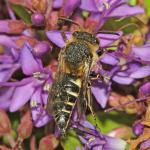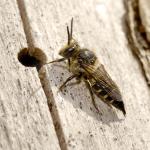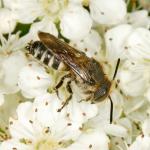Coelioxys simplex NYLANDER 1852; Coelioxys tricuspidata FÖRSTER 1853; Coelioxys denticulata SCHENCK 1855 ; Coelioxys stigmatica SCHENCK 1855; Coelioxys distincta SCHENCK 1855; Coelioxys sponsa SMITH 1855; Coelioxys tridenticulata SCHENCK 1861; Coelioxys gracilis SCHENCK 1861; Coelioxys obscura SCHENCK 1861; Coelioxys claripennis SCHENCK 1870; Coelioxys kudiana COCKERELL 1924; Coelioxys popovici FRIESE 1925
There are currently no published keys to Coelioxys. George Else has a key in preparation. A photographic guide to the genus is available for download from the BWARS website. A distinctive group of largely black bees, with the females of most species having a pointed tip to the gaster. This species flies low over the ground looking for its host’s nests, often in a purposeful manner.
Coelioxys elongata is found throughout mainland Britain from the south coast to Inverness in Scotland. It does appear to have a southerly and also coastal bias with an apparent absence from the entire English Midlands, and inland Scotland and Wales. Also recorded from Ireland and the Channel Islands.
Occurs in much of western and central Europe.
This species is not regarded as being scarce or threatened.
Coastal dunes, inland heaths, gardens and brownfield sites where its hosts occur.
This species’ flight period is from June through to August and is likely to appear slightly later than its host species.
This species is a cleptoparasite of Megachile willughbiella (Kirby) and M. circumcincta (Kirby). The females of all but one British species of Coelioxys have a pointed sixth tergite and fifth sternite which is apparently used to cut open the cell wall or cap of the host species. An egg is laid in this slit with at least one third protruding through into the cell or laid directly onto the host egg. There is currently no work to suggest which method C. elongata employs. Generally, Coelioxys larvae kill, and in some species eat, the host egg
immediately on hatching. Pupation occurs within a cocoon spun within the host cell where the larva overwinters as a pre-pupa, prior to final pupation, presumably in the spring of the following year.
It is likely to visit bird’s-foot-trefoils and possibly other legumes including species such as melilot.
No data available.
2012




